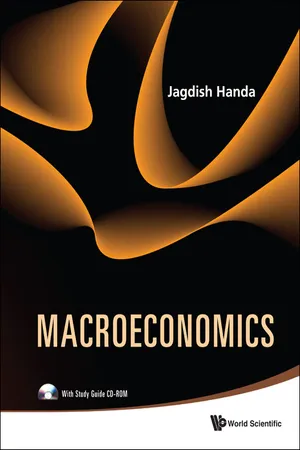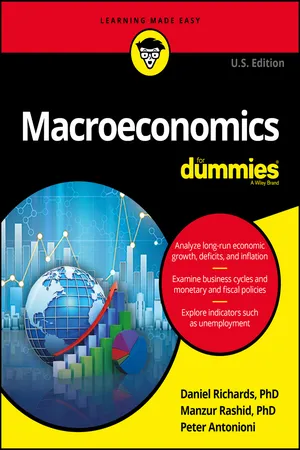Economics
Shifts in Long run Aggregate Supply
Shifts in long run aggregate supply refer to changes in the potential output of an economy over time. These shifts can be caused by factors such as changes in technology, labor force growth, and capital accumulation. An increase in long run aggregate supply leads to economic growth and lower price levels, while a decrease results in the opposite effects.
Written by Perlego with AI-assistance
Related key terms
Related key terms
1 of 4
Related key terms
1 of 3
4 Key excerpts on "Shifts in Long run Aggregate Supply"
- eBook - ePub
Macroeconomics
(With Study Guide CD-ROM)
- Jagdish Handa(Author)
- 2010(Publication Date)
- WSPC(Publisher)
y*) = 0. However, we cannot take it for granted that the real-world economies will meet these assumptions for each period of our study, when these periods are as short as, say, a month, a quarter, or a year. We, therefore, resorted to the analytical notion of the long run, which is defined as the stage in which these assumptions are met, so that the economy can be said to be at the full-employment (LR) level of output.Hence, the aggregate supply curve for the full-employment level of output is called the LR aggregate supply (LRAS) curve. It is applicable in the case of zero expectational errors, zero adjustment costs and lags, and equilibrium in the labor market and in production. It is strictly not applicable when these conditions are not met. However, the LR levels of output and employment can be used as a benchmark or reference state toward which the economy will tend to move. If it does not do so of its own volition or does not do so fast enough, macroeconomics (see Chapters 8 and 9 ) examines the policies that can induce such a movement.7.11.1 Changes in the actual rate of output over timeThe actual level of output alters over time because of changes in any or all of its three components since:As we have argued earlier, the full-employment level of output does change over time due to shifts in technology and in labor supply. The other two components of the actual level can also change and do change over the business cycle. In particular, they are positively related to the business cycle and tend to have positive values during a boom than during a recession. They can be changed by monetary and fiscal policies.7.12 The Rate of UnemploymentThis chapter has focused on the long-run analysis of output and employment. Changes in unemployment and its rate are the converse of those in employment, so that we now derive the implications of the long-run analysis for unemployment. Chapter 10 - eBook - ePub
- Dan Richards, Manzur Rashid, Peter Antonioni(Authors)
- 2016(Publication Date)
- For Dummies(Publisher)
Chapter 10 for details). In the short run, the interaction of aggregate supply and aggregate demand determines how much a country produces (GDP) and how much on average those goods will cost to purchase (the price level), as well as how fast that price level is changing (inflation), plus how much unemployment an economy experiences.Looking at long-run aggregate supply
Economists distinguish between the short run and the long run because the economy behaves in a different way depending on the time frame you’re looking at. The important thing about the long run is that prices are fully flexible (they can change a lot), whereas in the short run prices are sticky (they don’t change by very much — check out the later section “Pulling apart why prices can be sticky ” for some suggested causes of this stickiness).Saying that prices are sticky is a way of saying something important about the behavior of suppliers. When demand for any product increases, the businesses that make those goods can do one of three things:- Hold output constant and raise their price until the extra demand is choked off
- Hold the price constant and increase supply enough to meet all the new demand
- Do a bit of both
The same options arise for the workers, who supply labor, and the capitalists who supply capital to the firms. In response to a rising demand for their services, they can supply more labor and capital services, raise their compensation demands, or, again, do some of both.In the long run, it’s the first option that best describes agents’ behavior in a macro sense. Given enough time, a rise in demand leads to a higher overall aggregate price level P (and higher wages, too) but no more output. In the short run, it’s the second choice that rules. Initially, prices and wages are held in check in response to a demand shock. The result is that, in the short run, a rise in demand evokes mostly an increase in production, whereas a fall in demand induces production to fall. In this section, we review briefly the long-run supply behavior, which is really what the growth model of Chapter 8 - No longer available |Learn more
Contemporary Economics
An Applications Approach
- Robert Carbaugh(Author)
- 2016(Publication Date)
- Routledge(Publisher)
- The model of aggregate demand and aggregate supply can be used to show how output and prices are determined in the short run. An economy is in equilibrium when aggregate demand equals aggregate supply.
- The aggregate demand curve shows the total amount of real output that buyers will purchase at alternative price levels during a given year. Movements along an aggregate demand curve are caused by changes in the price level of the economy. Shifts in the aggregate demand curve are caused by changes in non-price factors that affect household consumption expenditures, business investment, government expenditures, and net exports of goods and services.
- According to the multiplier effect, a change in any one of the components of aggregate demand (consumption, investment, government spending, or net exports) will have a magnified impact on national output and income. The size of the multiplier depends on the spending and saving habits of consumers and businesses.
- The aggregate supply curve shows the relationship between the level of prices and amount of real output that will be produced by the economy in a given year. The aggregate supply curve is horizontal when the economy is in deep recession or depression, upward-sloping when the economy approaches full employment, and vertical when the economy achieves full employment. Changes in factors such as resource prices, resource availability, and the level of technology will cause the aggregate supply curve to shift.
- The model of aggregate demand and aggregate supply can be applied to the problems of recession and inflation. According to this model, decreases in aggregate demand or aggregate supply can push the economy into recession; inflation may be the result of increases in aggregate demand or decreases in aggregate supply. An economy experiences “stagflation” when there is both recession and inflation.
- eBook - ePub
Patentism Replacing Capitalism
A Prediction from Logical Economics
- Samuel Meng(Author)
- 2019(Publication Date)
- Palgrave Macmillan(Publisher)
3 .So far, we have assumed that the short-run AS is steeper than the long-run AS. The reasoning behind this assumption is that, due to the fixed capital or firm size in the short run, the cost of production in the short run increases faster than that in the long run. The other factor that needs to be taken into account is the input price. When the output level is high, the pressure on limited resources will drive up input prices and increase the long-run production cost sharply. However, firms are unable to perceive resource limits correctly in a timely fashion, so the slope of the short-run AS curve is unlikely to be affected by a future rise in input costs. This will create a situation where the slope of LRAS is greater than that of SRAS when production is approaching resource limits, shown as SRAS4 and SRAS5 in Fig. 4.31 .In this case, when a positive demand shock shifts the aggregate demand from AD4 to AD5 , the output level will increase to point G where AD5 intersects with SRAS4 . Here, the output can be greater than the resource limit can support, because we assume a soft resource limit, or a limit with a buffer. There is no economy operating at absolute resource limit, but when it is close to this limit (i.e. within the buffer zone), the extremely high price makes it very hard to go further to reach the absolute limit. The buffer zone can be viewed as a soft resource limit. Once the firm realizes the unexpected degree of the input prices hike and revises its production cost by including the factor of input price increases, the short-run supply curve shifts to SRAS5 and the output level falls back to the level supported by soft resource limits. It is worth mentioning that this explanation is similar to but actually different from the money illusion argument because there is no change in the money supply here.- 2. Business cycles and economic growth
Index pages curate the most relevant extracts from our library of academic textbooks. They’ve been created using an in-house natural language model (NLM), each adding context and meaning to key research topics.
Explore more topic indexes
Explore more topic indexes
1 of 6
Explore more topic indexes
1 of 4



